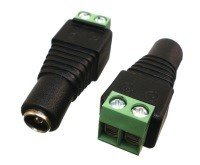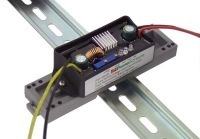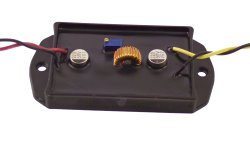Use a DC converter to get
that 24VDC
So you want to power a 24VDC device, such as a PLC, linear
actuator, LED strip, stepper motor controller or microphone from your desktop.
Here is an easy way to get that voltage. Sorry, it is not possible or
practical to extract 24 Volts directly from the ATX PSU. You can't use two of
the 12V lines wired in series because they have a common ground (and actually
they are from a common positive source as well). You might try to series the
-12 and +12 but there is very little power available, and you still have to be
worried about the 24V device's grounding, since that source of 24V has to be
floating. But what you can do, and very easily, is to use a DC/DC converter.
This little module is very useful for this purpose, and can get you up to 50
watts (or higher for short spurts). So even though you can't get 24V from the
ATX, you can "cheat" by including another DC converter, the
PST-DCBP-24V.
The best source of power in the computer is the +12V rail.
The PST-DCBP will boost 5V or even 3.3V to +24V, but the efficiency is lower,
so to control the heat you would have to limit the power to 10W to 20W. The
+12V rail also contains most of the power in the larger ATX PSU form factor.
And if you want a different voltage, you can adjust the trim-pot over a
wide variety of voltages, such as 15V, 19V, or 21V. Yes you could even charge
your laptop from your ATX.
To tap power from the computer use one of the
spare hard drive connectors, the yellow wire is +12V, and the black wire is, of
course, ground.
| |
Quantity |
1-9 |
10-99 |
100-999 |
1000+ |

PST-DCBP-24V |
 |
$49 |
$46 |
$39 |
Call |
Optional barrel socket to screw terminal
adapters
|
Price |
ZHJX002

5.5 x 2.1 mm barrel socket |
$2.50 each
 |

5.5 x 2.1 mm barrel plug |
$2.50 each
 |
Optional DIN mounting
hardware
 (not including the rail) (not including the rail) |
$3.00
 |
|
| Input operating voltage |
2.9V to 23 VDC if you want 24VDC output, remember this DC
converter will only increase the input voltage |
| Output voltage |
24VDC set at the factory, you can easily adjust it
yourself, up to 38V. Examples are 15V, 19V, 21V |
| |
Note: the output voltage must be higher than the input
voltage
Note: the output voltage is adjustable by a trim pot from the top of
the package. We will adjust it to 24V before shipping unless you request a
specific voltage when ordering. |
| Output Power |
Boosting 12V to 24V you can run up to 50 watts
continuously, or even higher for brief excursions |
| Maximum output current |
Up to 2.1 amps continuous with 12V input and 24V
output |
| Under voltage lockout |
2.6V ± 0.1V |
| Temperature Range |
-35C to +60C |
| Electrostatic immunity |
Human body model ±2000V |
| Operating temperature range |
-20°C to +75°C (-4°F to 167°F) |
| Over current protected |
Pulse by pulse over current protected |
| Over current protection |
Yes, by reverse biased diode across the input terminals. A
fuse in the input line is required to prevent damage. |
| Thermal protected |
Automatic restart with 15°C hysteresis |
| Size |
104x52x13mm (4x2x0.5 inches) including flange |
| Weight |
2.4 oz, 68g |
|


